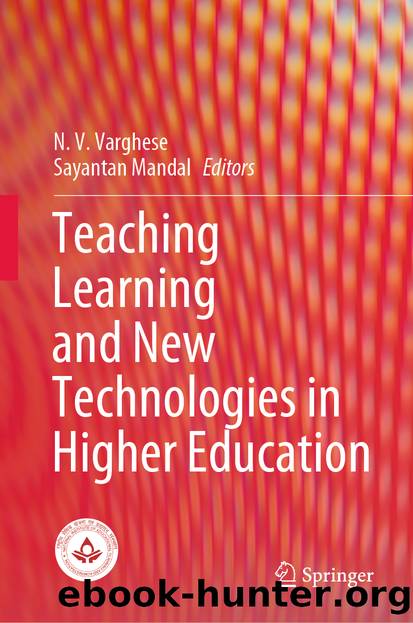Teaching Learning and New Technologies in Higher Education by Unknown

Author:Unknown
Language: eng
Format: epub
ISBN: 9789811548475
Publisher: Springer Singapore
Undergraduate Colleges: Changing Scenario in Classrooms
As mentioned earlier, undergraduate education accounts for nearly 80% share of enrolments in higher education institutions in the country. The participants recognized that teaching in colleges has become much more demanding because of increasing numbers as well as the heterogeneity of the student population. It was pointed out that increased diversity is resulting due to twin reasons namely entry of a large number of first-generation learners and secondly due to an increase in the mobility of students. This mobility may be due to move for getting access, shift from rural to urban institutions, or issue of quality, i.e. desire to move to a better institution. The study strongly emphasized that increased student diversity in the classrooms creates challenges for teachers and teaching. During the discussions, it was stated that studentâs characteristics differ due to their different socio-economic and regional backgrounds such as previous academic experiences, their attitude, and motivation decides their learning outcomes and learning abilities.
Teaching a highly diverse class consisting of first-generation learners, students from disadvantaged background, rural students, high achievers, and others is a challenge for the teacher. Teaching students who have studied in regional or local languages is another challenge in the classroom, e.g., students in state of Maharashtra complete their schooling in Marathi medium, whereas in college courses may be offered in different instruction mediums. The study noted that teaching-learning in multilingual class rooms create a difficult situation for students especially for the first generation learners or the ones who moved from rural to urban areas as they are unable to understand or keep pace in the class and eventually lag behind in achieving learning outcomes.
Increase in student numbers in the classroom, i.e., large classrooms was stated as one of the biggest constraints to attempt innovation in teaching-learning process. Due to very large class strength, accommodating all the students in the classroom is also a challenge. Teachersâ focus remains on completion of course in time. In such a situation, teaching for developing problem-solving abilities or critical thinking skills through other teaching methods take a back seat, and to achieve expected learning outcomes becomes a challenge. The class management for effective teaching-learning and to address the individual needs of heterogeneous group is a challenge. This also influences the student-teacher engagement in tutorials, project work, etc.
There are colleges where student absenteeism is reported as one of the biggest hurdles in achieving the desired learning outcomes. This is in spite of the fact that students are required to attend at least 60% of classes for being eligible to sit in examinations, as per the university rules. The government colleges and constituent colleges face high absenteeism due to various reasons. Many students do not attend classes because they prepare for competitive exams in order to secure admission in professional courses or even for entering into a better educational programme and/or college. There are others who join coaching classes or work along with the studies.
There are students who are not interested to come to class as they feel they can learn better on their own.
Download
This site does not store any files on its server. We only index and link to content provided by other sites. Please contact the content providers to delete copyright contents if any and email us, we'll remove relevant links or contents immediately.
The Art of Coaching Workbook by Elena Aguilar(48066)
Trainspotting by Irvine Welsh(20056)
Twilight of the Idols With the Antichrist and Ecce Homo by Friedrich Nietzsche(17707)
Fangirl by Rainbow Rowell(7834)
Periodization Training for Sports by Tudor Bompa(7329)
Change Your Questions, Change Your Life by Marilee Adams(6641)
This Is How You Lose Her by Junot Diaz(5774)
Grit by Angela Duckworth(4738)
Red Sparrow by Jason Matthews(4668)
Asking the Right Questions: A Guide to Critical Thinking by M. Neil Browne & Stuart M. Keeley(4576)
Paper Towns by Green John(4169)
Room 212 by Kate Stewart(4107)
Ken Follett - World without end by Ken Follett(3973)
The Sports Rules Book by Human Kinetics(3588)
Housekeeping by Marilynne Robinson(3402)
The Motorcycle Diaries by Ernesto Che Guevara(3333)
Introduction to Kinesiology by Shirl J. Hoffman(3301)
Exercise Technique Manual for Resistance Training by National Strength & Conditioning Association(3292)
Double Down (Diary of a Wimpy Kid Book 11) by Jeff Kinney(3274)
